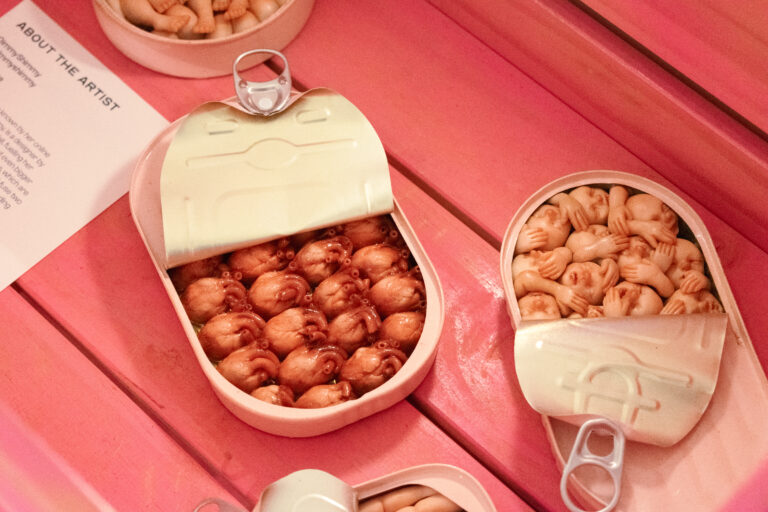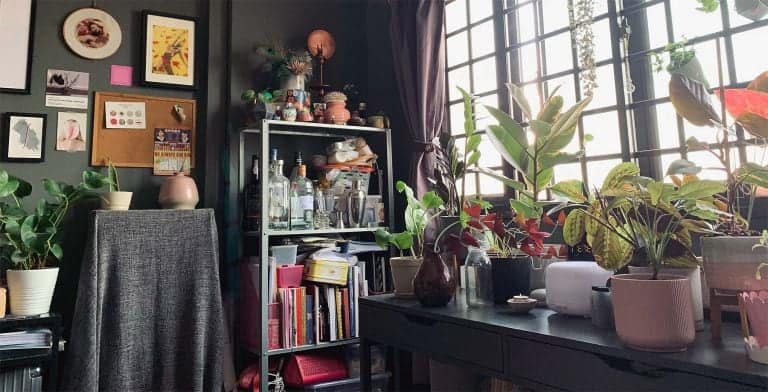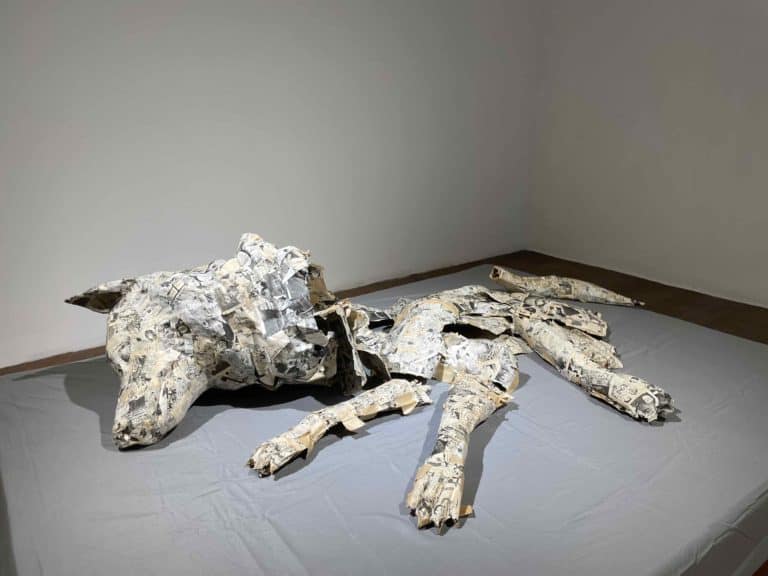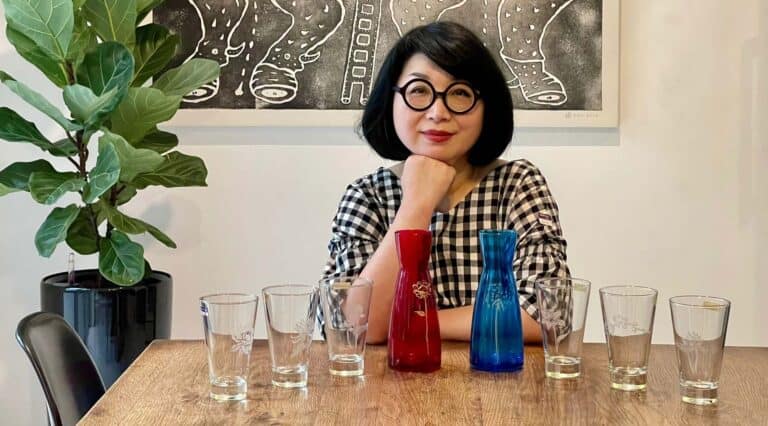So you want to collaborate, but how do you know you’ve found the right collaborator?
“Find someone who will laugh at your jokes,” was the tip given to me by artist Zen Teh. A moment of silence, and then her collaborator Wyn-Lyn Tan burst into laughter. I couldn’t help it myself, and soon all my audio recorder could catch was the sound of giggling.
I was speaking to Zen and Wyn-Lyn at the NIE Art Gallery, a blocky building on the far-flung edges of Singapore, nestled amongst the nature of Nanyang Crescent. The two artists were about to deliver their final artist tours of their collaborative exhibition, Peripheral Spaces, as part of the Singapore Art Week 2022 programme.
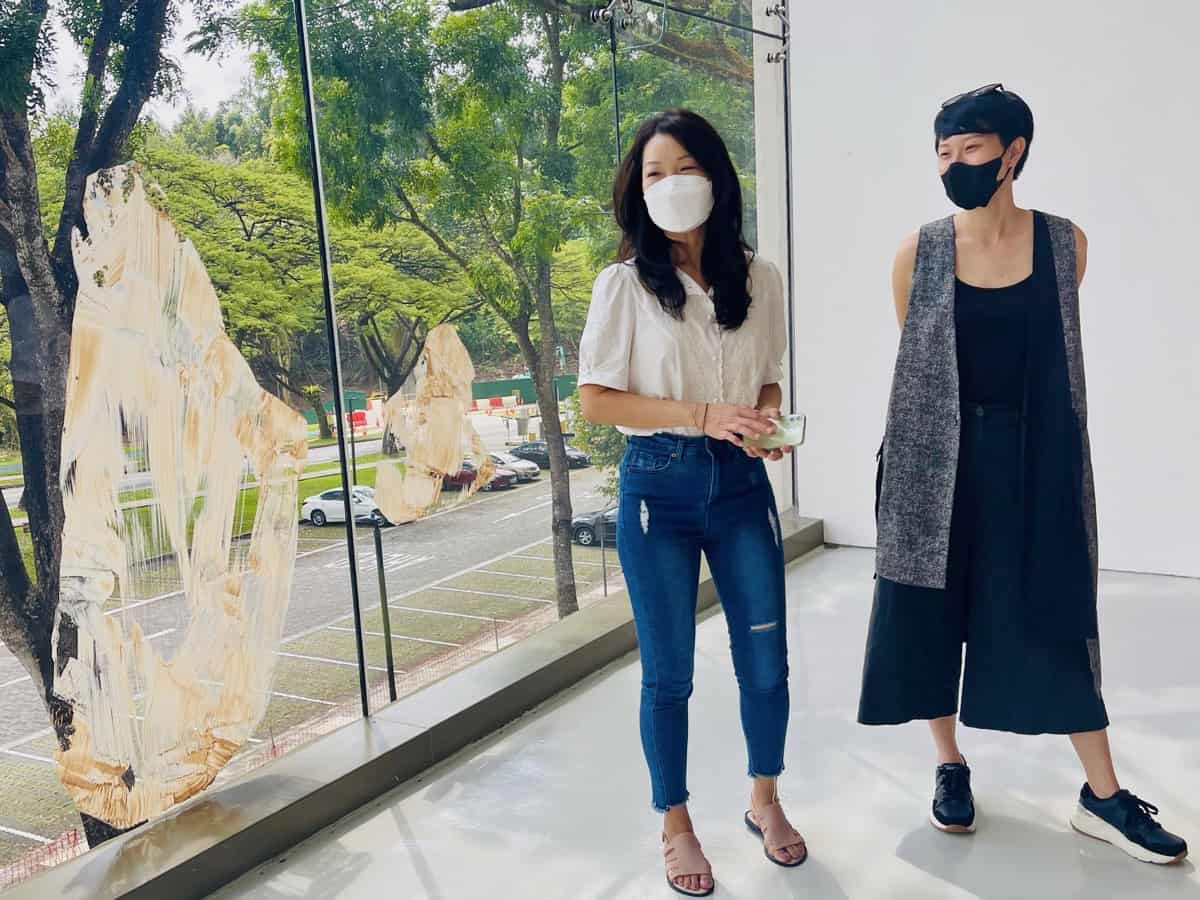
Curated by Hera Winata, the exhibition features new works co-created by Zen and Wyn-Lyn, ranging from installation works hidden in plain sight outdoors to painterly sculptural pieces in an airy gallery space. Combined with a delightful virtual exhibition experience designed by Lim Shu Min, the exhibition seamlessly blends different mediums to muse on the complex relationship between the man-made and natural.
I’ve always thought of collaborations as a give-and-take exchange of two artists requiring much time and effort. But maybe I’d gotten it all wrong — is a matching sense of humour truly the most important factor?
And if not, then what?
An alignment of the stars
Zen and Wyn-Lyn have the easy-going camaraderie of people that have known each other for a long time, so I was surprised to find out that they’ve only been working together since late 2021.
Objectively, the two artists have much in common. They both have an image-based approach, with strong interests in the natural world and phenomena. They also happen to both have studio spaces at Telok Kurau Studios. Yet, until 2021, they orbited similar circles in the local art scene without really connecting or talking to each other.
That changed one day when they bumped into each other at the traffic junction near the studio. From the beginning, collaboration was on the plate. Zen’s practice involved a lot of interdisciplinary collaboration, while Wyn-Lyn’s practice sees her as a singular conduit of her experience of the world. This type of collaboration, between two artists, is a first for the two.
In the world of contemporary visual arts, a lot of time is spent talking about concepts, and it can almost seem archaic to group artists strictly by their visual style. However, for these two artists, the starting point of their collaboration was built on an inherent trust in each other’s visual aesthetics.
Making negotiations visible
Art may be a visual language, but the process behind it isn’t always visible. Being an artist means constantly negotiating with yourself on every artistic decision. This internal dialogue of research, judgement and decision-making often goes on without leaving a single physical trace, a process that becomes as intuitive as a football player ingraining the action of kicking a ball into their muscle memory.
But when someone else is brought into our inner dialogue, things get complicated. Everyday actions like walking or eating can appear deceptively simple, but are the result of a complicated string of thoughts and actions. How do you even begin to explain to another person a process that feels so intuitive? To address this problem, Zen and Wyn-Lyn sought out a simple solution to make their thought processes visible: drawing.
Looking at their collaborative sketch for the Panoramic Fragments installation reveals much more about the artists than it did the work. Sensitive yet decisive, the sketch places a clear emphasis on the interplay of light and darkness. It reveals not only their strengths in creating powerful compositions, but also their openness to each other’s opinions.
Drawing was not the only tool they used in this negotiation, as they had also gone outdoors to photograph, touch, and sense things together. Truth is, none of these actions is as important as the willingness to come to the table and lay all their cards out for each other to see. Vulnerability, it seems, is the secret to successful artistic negotiations.
Embracing the Unknown
Both artists’ practices embrace and make sense of unpredictability. Zen’s practice is heavily research-driven, and a long process of investigation informs the outcomes. Wyn-Lyn too has talked about how the uncertain rhythms of nature inform her works.
In their individual works in Peripheral Space, the artists strike a careful balance of chance and control, creating works that are sensitively packaged and intricate. These individual works, like Mapping Temporalities and Locus of Time pictured below, articulate a delicate relationship between time and place.
In their collaborative practice, however, uncertainty becomes an assertive third collaborator that stretches the scale and ambition of the artwork.
Sometimes this uncertainty comes in through the site-specificity of the works. The works, though made of sturdy materials like rocks and metal, somehow seem to yield to and morph with the environment, adjusting themselves to subtle shifts in wind direction and light.
At other times, this uncertainty is exerted by the inevitable tension between two people coming together to create a single vision. This tension is inherent in every human interaction, the gap between people that makes each individual who they are. These gaps create works that are less precious and stately, and instead embody the imperfect beauty of wabi-sabi.
Through navigating these uncertainties, Zyn and Wyn-Lyn have developed a new artistic language in their collaborative pieces that is less restrained; one that transcends the quiet delicacy present in their individual works.
Intense experiences create trust
Some other collaborative practices have been leisurely carried out with the luxury of time — such as Christo and Jeanne-Claude’s monumental joint practice, which was honed over decades. On the other hand, the works in Peripheral Spaces were created in a time crunch at the end of 2021.
“We worked till the 11th hour until the installers came,” said Wyn-Lyn, recalling the show’s intense preparations. As the two artists recalled getting into the studio early just to finish their preparations, they laughed once more. The way they made the curator panic in those final moments had already turned into a positive memory.
So the secret to a good collaboration is… the joy of shared suffering?
We might laugh about this, but in some way, we all know it rings true. Just think about any experience you have had with someone, where stress and uncertainty became the foundation of a strong kinship. But it’s not just about putting two people together and getting them to suffer.
As part of the research for their artworks, the artists visited junkyards, observed changes in weather and light, and even lugged around large, clumsy sheets of rusted metal as part of their work Salvaged Topographs. Together, they approached the labour with curiosity and lightness. When they talk about each other’s work ethic, creative joy gives way to deep respect, and personal values of perseverance and determination become artistic values.
Fostering abundance in collaboration
Collectivist endeavours have made their mark on Singapore’s art history, from the Chinese male-dominated club of Nanyang artists to the keenly communal nature of The Artists Village. However, creating art today can be a fundamentally individual experience, if not always a lonely one.
It’s clear from my conversations that Zen and Wyn-Lyn, in contrast, work closely to embrace an abundance mindset. This refers to the belief that there is more than enough opportunity to go around, and that successes are best shared. In collaborations, putting the individual ego aside and adopting this mindset means that every new idea is embraced as a possibility, not a complexity.
Just like in any industry, the unspoken rules of competition and self-protection can result in guardedness and invisible walls of perceived scarcity. Opening one’s practice up to another artist the way Zen and Wyn-Lyn did becomes an immediately powerful expression of trust.
So where to, from here? Zen and Wyn-Lyn shared plans to continue working with Hera and Shu Min as an ongoing collective. They speculated that future projects could be led by different people and have in-roads into virtual experiences, architecture, or art history.
Collaboration can sometimes be a word carelessly thrown around as though it creates value in and of itself. I admit to being somewhat sceptical of the concept, having seen it used far too liberally to cover a wide range of hodge-podge buzzwordy initiatives between mass-appeal creatives and commercial brands, both in and outside the art world.
Seeing the level of trust and honesty between Zen and Wyn-Lyn, however, helped me to realise that a good collaboration doesn’t just mean investing time and effort, but also being vulnerable and attentive to each other. When done right, this creates new possibilities in art-making.
It’s the small things
When we first sat down to chat, the two artists graciously allowed me to take a seat facing Salvaged Topographs, an outdoor installation on a gentle slope. We had spoken a lot about their interest in the effects of changing light and time on nature, so my eyes were drawn to a delicate web of shadows cast by nearby trees that suddenly appeared on the grass, caused by clouds parting above.
Almost as soon as I had noticed it, Zen pointed at the same sight and exclaimed that the shadows were why they had chosen that spot for the work. Wyn-Lyn’s head also snapped around, and together, we shared an appreciation for that fleeting moment.
What I learnt from Zen and Wyn-Lyn is that the right collaborator must be willing to share something infinitely more precious than just a sense of humour; they must be willing to give you their complete attention and trust, even in the smallest of moments.
____________________________________
Click on the respective links to learn about Zen Teh and Wyn-Lyn Tan.
Learn more about Zen Teh’s latest outdoor art installation at Jurong Lake Gardens here. The installation will run from 5 pm to 9pm, until 27th April 2022.



















